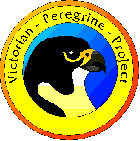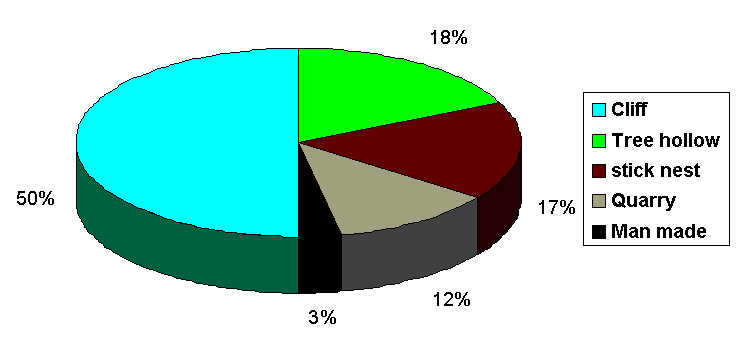

The Peregrine Falcon Falco peregrinus
is considered to be the fastest bird in the world. Radar guns
have clocked birds diving at speeds up to 320 kilometres per hour.
The original Latin name peregrinus describes
the wandering nature of the species. That is, in the northern
hemisphere (where the species was first described in the middle
ages) the species is a migrant to the extent that its behaviour
mirrors that of its prey populations. However, in Australia because
of less dramatic seasonal weather changes both the Peregrine and
its prey can maintain year round territories. Thus it is considered
to be a sedentary species on this continent.
The Peregrine is a cosmopolitan species found
on all continents and most large islands with the exception of
Antarctica and New Zealand. There are 17-19 subspecies recognised
(depending on the taxonomic system used).
DESCRIPTION
As with most raptors, females on average noticeably larger than males.
Length 35-50cm; wing span 80-105cm; weight
female 890g, male 600g.
ADULT PLUMAGE
Slate-blue above, mottled darker; white or
creamy buff below, unmarked upper breast forming conspicuous pale
bib; lower breast and trousers finely barred black, they seem
grey from a distance. Wholly black crown and cheeks. Bill blue-grey,
tipped black; cere, eyering and legs yellow.
IMMATURE PLUMAGE
Dark-brown above including head and cheeks;
finely margined pale-buff or rufous; buff to deep buff below,
breast streaked or spotted blackish; flanks and trousers with
irregular V bars; cere, eyering and legs bluish.
PREY SPECIES
Prefers flocking species, however, is known
to take large a range of species from Sparrows, Starlings, Silver
Gulls, Galahs, Rosellas, Pigeons, Honeyeaters, Terns, Cockatoos,
up to Egrets and Ibis. As many as 60 species of birds have been
recorded in the diet of Australian Peregrines. Within these numbers
the make up of the diet will vary from different locations.
HUNTING TECHNIQUE
They kill by mid air collision with their prey
often at the end of a long and very fast dive (called a stoop).
As such, during the middle ages Peregrines were highly prized
for the sport of falconry. Falconry was banned in Australia in
1975.
NEST SITES
Peregrines across Victoria are known to select three broad nest site types. Roughly in order of preference: ledge or cave on cliff face; disused stick nest in tree or tree hollow; or man made structure. The nest consists of a small scrape just large enough to accommodate the brooding adult and up to three or four eggs. Regardless of the nest site Peregrines do not bring any material to make (or add to) the nest. Each year the scrape is freshly scratched out with the talons (claws) and any prey remains littering the nest site are discarded. Apart from this pre-breeding clean up, Peregrines tend to be unconcerned with house keeping. The feathers and bones (of prey items) continue to built up in and around the nest site whilst the young are being reared.
Summary of Peregrine Nest types in Victoria

BREEDING BIOLOGY
Pairs mate for life. Mated pairs sedentary
within home territory often (but not always) nesting at the same
nest site year after year.
Nest site selection - early August
Egg laying - mid August to early October
Clutch size - 1 to 4 eggs. Normally only 2
to 3.
Incubation period - average 33 days.
Hatching - early September to late October
Fledging - late October to mid December
Average number fledged - 1 to 2
Birds gain their adult plumage in their second
or third year of life and although sexually mature at this age
may not find a mate or establish a nesting territory until they
are even older.
LIFE EXPECTANCY
Peregrines are known to have lived more than
20 years in captivity and are thought to live on average 4-5 years
in the wild. However, adults have been recorded still breeding
at 20 years of age in the wild. 90% of Peregrines die in their
first year. Those that survive have a high rate of survival to
their 12th year.
FURTHER READING
W.B. Emison et al May 1981 Peregrine Falcon Supplement to The Emu Volume 80, pp 249-296.
P.D. Olsen 1995 Australian Birds of Prey, UNSW Press.
C.M. White et al 1988 Atypical nesting habitat
of the Peregrine Falcon (Falco peregrinus) in Victoria, Australia,
Journal of Raptor Research 22(2):pp37-43.
Prepared by V.G. Hurley